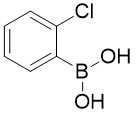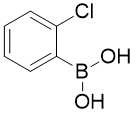
Cas 3900-89-8 2-Chlorophenylboronic Acid C6H6BClO2 670-392-1 Crystalline Powder
-
High Light
Cas 3900-89-8 Organic Intermediate
,2-Chlorophenylboronic Acid
,C6H6BClO2 Organic Intermediate
-
Product Name2-Chlorophenylboronic Acid
-
SynonymsO-CHLOROPHENYLBORONIC ACID;2-Chlorophenylboronic;2-Chlorophenylboronic Acid (contains Varying Amounts Of Anhydride)
-
CAS3900-89-8
-
MFC6H6BClO2
-
MW156.37
-
EINECS670-392-1
-
Melting Point92-102 °C(lit.)
-
Boiling Point306.3±44.0 °C(Predicted)
-
Density1.32±0.1 G/cm3(Predicted)
-
Storage Temp0-6°C
-
FormCrystalline Powder
-
ColorWhite
-
Place of OriginChina
-
Brand NameRUN
-
CertificationIOS9001
-
Model NumberRUN-Z
-
Minimum Order Quantity10g
-
Priceinquiry
-
Packaging Details50g 100g 500g 1kg 5kg 10kg
-
Delivery Time3-7 days
-
Payment TermsT/T, MoneyGram, BTCcoin
-
Supply Ability1kg --1000kg
Cas 3900-89-8 2-Chlorophenylboronic Acid C6H6BClO2 670-392-1 Crystalline Powder
SECTION 1: Basic information
| 2-Chlorophenylboronic acid Basic information |
| Product Name: | 2-Chlorophenylboronic acid |
| Synonyms: | 2-CHLOROBENZENEBORONIC ACID;2-CHLOROPHENYLBORNIC ACID;2-CHLOROPHENYLBORONIC ACID;AKOS BRN-0009;RARECHEM AH PB 0177;O-CHLOROPHENYLBORONIC ACID;2-Chlorophenylboronic;2-Chlorophenylboronic Acid (contains varying amounts of Anhydride) |
| CAS: | 3900-89-8 |
| MF: | C6H6BClO2 |
| MW: | 156.37 |
| EINECS: | 670-392-1 |
| Product Categories: | Boronate Ester;Potassium Trifluoroborate;blocks;B (Classes of Boron Compounds);Boronic Acids;Boronic Acids and Derivatives;BoronicAcids;Boronic Acid series;Boronic acids;Boronic Acid;Aryl;Organoborons |
| Mol File: | 3900-89-8.mol |
| 2-Chlorophenylboronic acid Chemical Properties |
| Melting point | 92-102 °C(lit.) |
| Boiling point | 306.3±44.0 °C(Predicted) |
| density | 1.32±0.1 g/cm3(Predicted) |
| storage temp. | 0-6°C |
| solubility | Soluble in DMSO, Methanol. |
| pka | 8.23±0.58(Predicted) |
| form | Crystalline Powder |
| color | White |
| BRN | 3030414 |
| CAS DataBase Reference | 3900-89-8(CAS DataBase Reference) |
| Safety Information |
| Hazard Codes | Xn,Xi |
| Risk Statements | 36/37/38-22 |
| Safety Statements | 37/39-26-36 |
| WGK Germany | 3 |
| Hazard Note | Irritant |
| TSCA | No |
| HazardClass | IRRITANT |
SECTION 2: Hazard identification
2.1 Classification of the substance or mixture
Not classified.
2.2 GHS label elements, including precautionary statements
| Pictogram(s) | No symbol. |
|---|---|
| Signal word | No signal word |
| Hazard statement(s) | none |
| Precautionary statement(s) | |
| Prevention | none |
| Response | none |
| Storage | none |
| Disposal | none |
2.3 Other hazards which do not result in classification
no data available
SECTION 3: Composition/information on ingredients
3.1 Substances
| Chemical name | Common names and synonyms | CAS number | EC number | Concentration |
|---|---|---|---|---|
| 2-Chlorobenzeneboronic acid2-Chlorophenylboronic Acid (contains varying amounts of Anhydride) | 2-Chlorobenzeneboronic acid2-Chlorophenylboronic Acid (contains varying amounts of Anhydride) | 3900-89-8 | - | 100% |
SECTION 4: First-aid measures
4.1 Description of necessary first-aid measures
If inhaled
Move the victim into fresh air. If breathing is difficult, give oxygen. If not breathing, give artificial respiration and consult a doctor immediately. Do not use mouth to mouth resuscitation if the victim ingested or inhaled the chemical.
Following skin contact
Take off contaminated clothing immediately. Wash off with soap and plenty of water. Consult a doctor.
Following eye contact
Rinse with pure water for at least 15 minutes. Consult a doctor.
Following ingestion
Rinse mouth with water. Do not induce vomiting. Never give anything by mouth to an unconscious person. Call a doctor or Poison Control Center immediately.
4.2 Most important symptoms/effects, acute and delayed
no data available
4.3 Indication of immediate medical attention and special treatment needed, if necessary
no data available
SECTION 5: Fire-fighting measures
5.1 Suitable extinguishing media
Use dry chemical, carbon dioxide or alcohol-resistant foam.
5.2 Specific hazards arising from the chemical
no data available
5.3 Special protective actions for fire-fighters
Wear self-contained breathing apparatus for firefighting if necessary.
SECTION 6: Accidental release measures
6.1 Personal precautions, protective equipment and emergency procedures
Avoid dust formation. Avoid breathing mist, gas or vapours.Avoid contacting with skin and eye. Use personal protective equipment.Wear chemical impermeable gloves. Ensure adequate ventilation.Remove all sources of ignition. Evacuate personnel to safe areas.Keep people away from and upwind of spill/leak.
6.2 Environmental precautions
Prevent further spillage or leakage if it is safe to do so. Do not let the chemical enter drains. Discharge into the environment must be avoided.
6.3 Methods and materials for containment and cleaning up
Collect and arrange disposal. Keep the chemical in suitable and closed containers for disposal. Remove all sources of ignition. Use spark-proof tools and explosion-proof equipment. Adhered or collected material should be promptly disposed of, in accordance with appropriate laws and regulations.
SECTION 7: Handling and storage
7.1 Precautions for safe handling
Handling in a well ventilated place. Wear suitable protective clothing. Avoid contact with skin and eyes. Avoid formation of dust and aerosols. Use non-sparking tools. Prevent fire caused by electrostatic discharge steam.
7.2 Conditions for safe storage, including any incompatibilities
Store the container tightly closed in a dry, cool and well-ventilated place. Store apart from foodstuff containers or incompatible materials.
SECTION 8: Exposure controls/personal protection
8.1 Control parameters
Occupational Exposure limit values
no data available
Biological limit values
no data available
8.2 Appropriate engineering controls
Ensure adequate ventilation. Handle in accordance with good industrial hygiene and safety practice. Set up emergency exits and the risk-elimination area.
8.3 Individual protection measures, such as personal protective equipment (PPE)
Eye/face protection
Wear tightly fitting safety goggles with side-shields conforming to EN 166(EU) or NIOSH (US).
Skin protection
Wear fire/flame resistant and impervious clothing. Handle with gloves. Gloves must be inspected prior to use. Wash and dry hands. The selected protective gloves have to satisfy the specifications of EU Directive 89/686/EEC and the standard EN 374 derived from it.
Respiratory protection
If the exposure limits are exceeded, irritation or other symptoms are experienced, use a full-face respirator.
Thermal hazards
no data available
